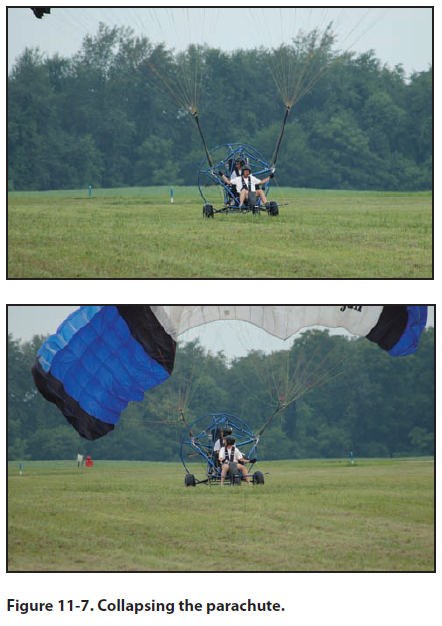|
Chapter 11 — Approaches and Landings
After-Landing Roll
The landing process must never be considered complete
until the powered parachute has been brought to
a complete stop, the engine shut down, and the wing
collapsed and on the ground. Many accidents have occurred
as a result of pilots abandoning their vigilance
and positive control after getting the powered parachute
on the ground. Some have damaged their parachute
by failing to stop the engine before the wing
falls into the moving propeller. Other incidents have
occurred where the wind has caught a still-inflated
wing and rolled the powered parachute over.
Normally as soon as you have landed, you should do
four things in this order:
1. Release any flare that was used during landing.
Once the flare is released, the wing will rotate
forward relative to the cart. That decreases both
the angle of attack and lift that the landing flare
generated. With the flare released, there will be
more load put on the front landing gear, which
in turn makes the powered parachute easier to
ground handle.
2. Unless you have the intention to taxi the powered
parachute with the parachute inflated, close the
throttle.
3. Shut down the ignition system. Normally,
powered parachutes have two toggle ignition
switches. Both toggle switches must be turned
off to shut down the engine.
4. The parachute needs to be collapsed and
grounded. This is done by tugging on the
parachute steering lines. One long pull will
generally not be adequate. Three or four quick
tugs will normally be enough. The wing rotating
and collapsing behind the cart will also act as
a brake for the powered parachute, much like a
drogue chute. [Figure 11-7]

Landings should always be planned to be done directly
into the wind. However, if you must land in a
crosswind, you may be able to land but you will not
be able to takeoff. You can land on higher crosswinds
than you can take off.
A wide runway may allow you the capability to land
across the runway. However, a narrow runway would
not allow this. Therefore, if you must land in a crosswind,
during final approach, crab into the wind and
line up on the runway centerline. Approach with this
crab and flare as you normally would. Reduce power
as your back wheels touch. When your back wheels
touch, your front wheel will swing around, straight
down the runway. However your wing will still be
headed into the wind. Shut the engine down and continue
pulling the steering lines to get the canopy down
on the ground immediately since you can not taxi in
a crosswind.
|

